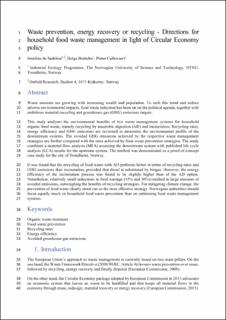| dc.contributor.author | de Sadeleer, Irmeline | |
| dc.contributor.author | Brattebø, Helge | |
| dc.contributor.author | Callewaert, Peter Guido | |
| dc.date.accessioned | 2021-03-02T16:16:30Z | |
| dc.date.available | 2021-03-02T16:16:30Z | |
| dc.date.created | 2020-05-20T08:46:18Z | |
| dc.date.issued | 2020 | |
| dc.identifier.citation | Resources, Conservation and Recycling. 2020, 160 (104908), . | en_US |
| dc.identifier.issn | 0921-3449 | |
| dc.identifier.uri | https://hdl.handle.net/11250/2731260 | |
| dc.description.abstract | Waste amounts are growing with increasing wealth and population. To curb this trend and reduce adverse environmental impacts, food waste reduction has been sat on the political agenda, together with ambitious material recycling and greenhouse gas (GHG) emissions targets.
This study analyses the environmental benefits of two waste management systems for household organic food waste, namely recycling by anaerobic digestion (AD) and incineration. Recycling rates, energy efficiency and GHG emissions are reviewed to determine the environmental profile of the downstream systems. The avoided GHG emissions achieved by the respective waste management strategies are further compared with the ones achieved by food waste prevention strategies. The study combines a material flow analysis (MFA) assessing the downstream system with published life cycle analysis (LCA) results for the upstream system. The method was demonstrated as a proof-of-concept case study for the city of Trondheim, Norway.
It was found that the recycling of food waste with AD performs better in terms of recycling rates and GHG emissions than incineration, provided that diesel is substituted by biogas. However, the energy efficiency of the incineration process was found to be slightly higher than of the AD option. Nonetheless, relatively small reductions in food wastage (15% and 30%) resulted in large amounts of avoided emissions, outweighing the benefits of recycling strategies. For mitigating climate change, the prevention of food waste clearly stood out as the most effective strategy. Norwegian authorities should focus equally much on household food waste prevention than on optimising food waste management systems. | en_US |
| dc.language.iso | eng | en_US |
| dc.publisher | Elsevier | en_US |
| dc.rights | Attribution-NonCommercial-NoDerivatives 4.0 Internasjonal | * |
| dc.rights.uri | http://creativecommons.org/licenses/by-nc-nd/4.0/deed.no | * |
| dc.title | Waste prevention, energy recovery or recycling - Directions for household food waste management in light of Circular Economy policy | en_US |
| dc.type | Peer reviewed | en_US |
| dc.type | Journal article | en_US |
| dc.description.version | acceptedVersion | en_US |
| dc.source.pagenumber | 9 | en_US |
| dc.source.volume | 160 | en_US |
| dc.source.journal | Resources, Conservation and Recycling | en_US |
| dc.source.issue | 104908 | en_US |
| dc.identifier.doi | 10.1016/j.resconrec.2020.104908 | |
| dc.identifier.cristin | 1811826 | |
| dc.description.localcode | "© 2020. This is the authors’ accepted and refereed manuscript to the article. Locked until 19.5.2022 due to copyright restrictions. This manuscript version is made available under the CC-BY-NC-ND 4.0 license http://creativecommons.org/licenses/by-nc-nd/4.0/ " | en_US |
| cristin.ispublished | true | |
| cristin.fulltext | postprint | |
| cristin.qualitycode | 1 | |

